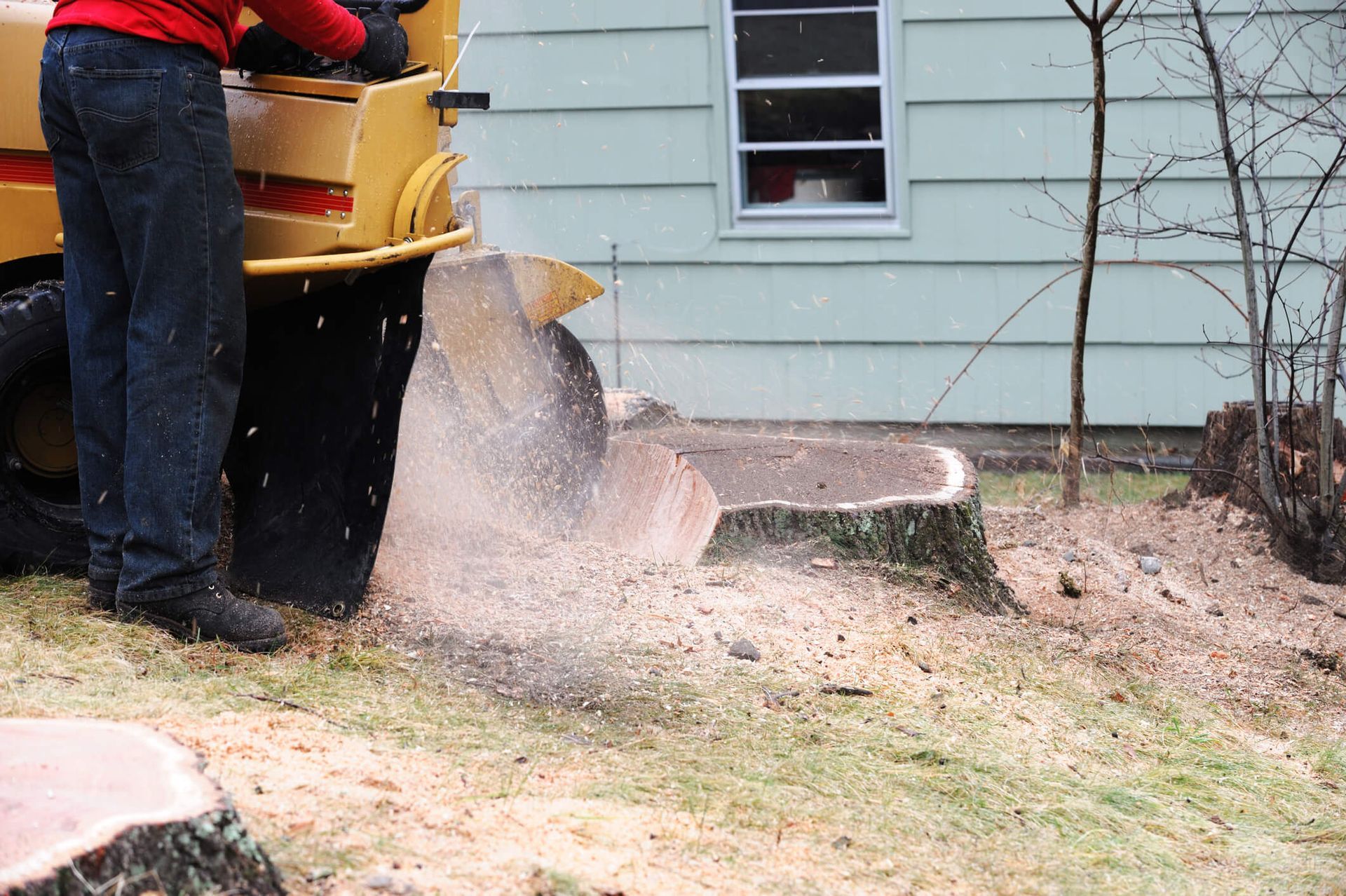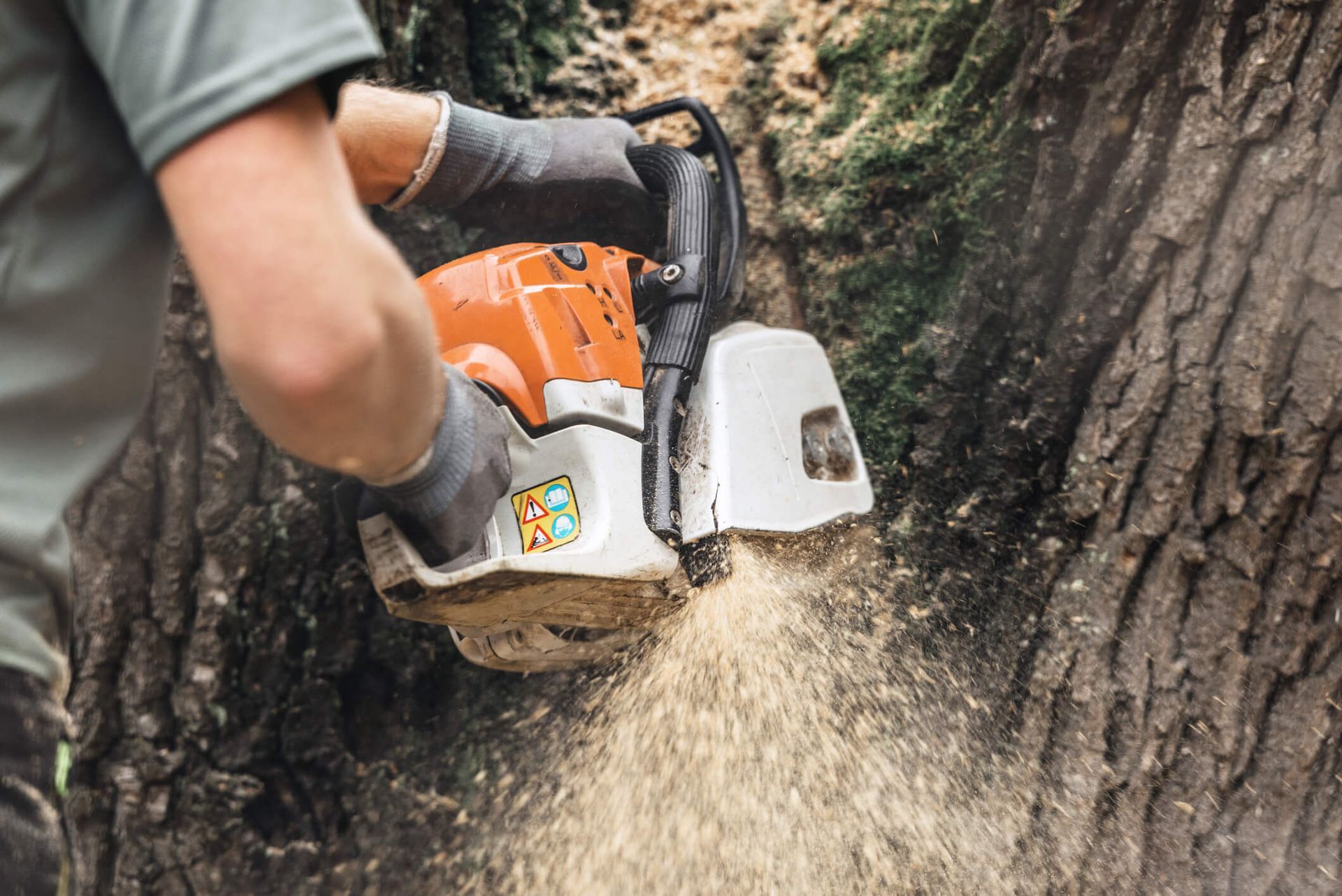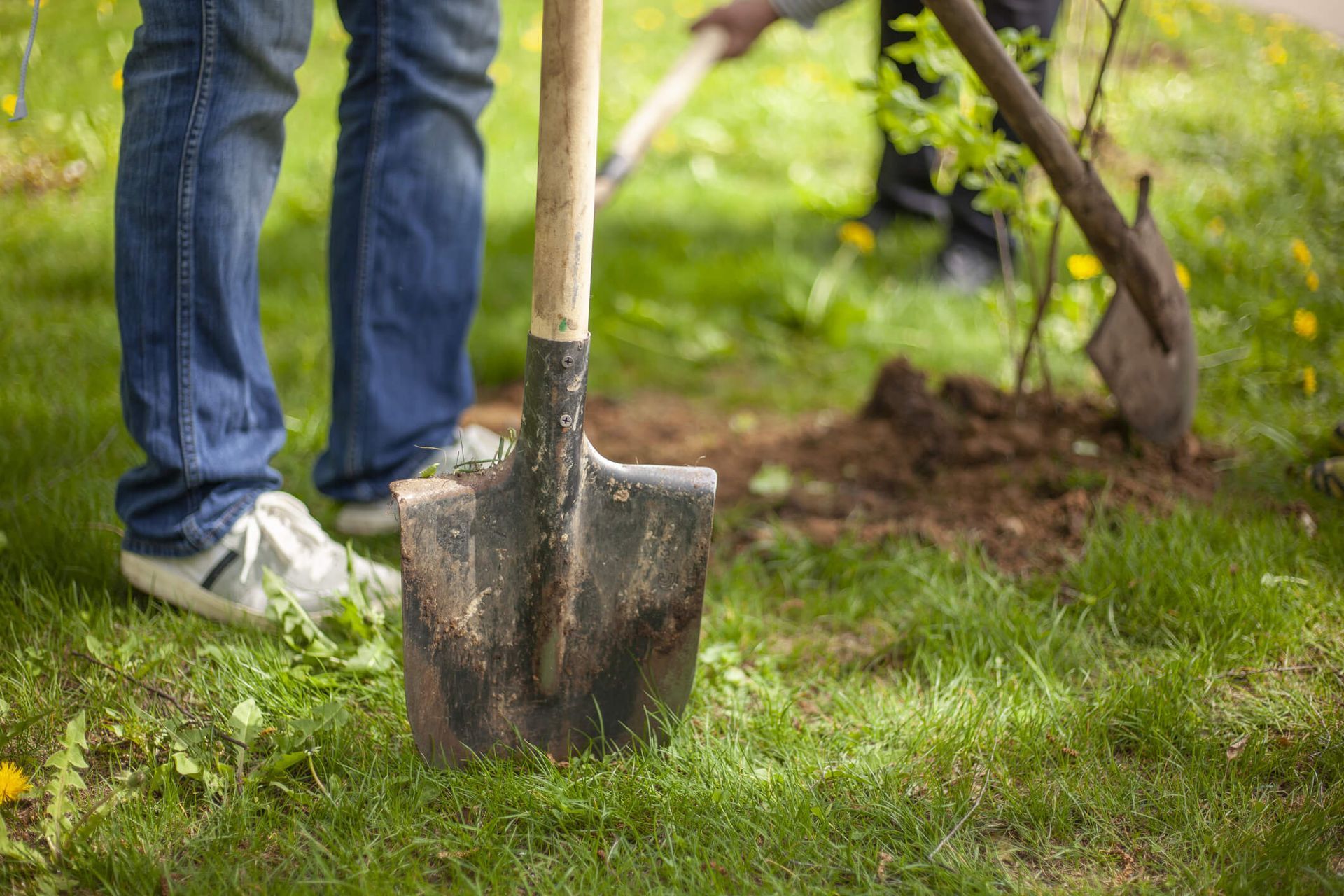Stump Grinding vs Removal
The result of removing a tree from your yard is frequently an ugly stump, which can become a problem if not adequately addressed. Choosing the proper stump removal method may seem an afterthought, but it's crucial for your environment's health and aesthetics. At SYS Enterprises, our team offers expert advice on different tree stump removal options, including stump grinding and complete removal. Each method has unique benefits, risks, and reasons to choose one, depending on your project. Stump grinding involves using a chipper to grind the stump below ground level, while tree stump removal eliminates the entire piece. Both approaches have pros and cons; selecting the best tree service for your needs is critical. If you need more clarification, please contact our company for guidance on the best solution for your yard.
What is Stump Grinding?
Stump grinding reduces a stump to tiny wood chips using a specialized grinder. This technique leaves the root system intact and treats only the visible area of the stump. This method can offer several advantages for homeowners, including a quicker cleanup and less disruption to the surrounding area. It also minimizes the chances of decay spreading to nearby plants or the risk of attracting pests. The cleanup process is usually more straightforward than complete stump removal, leaving only small chips that can be used for mulch or other purposes. However, there's still a chance that some roots remain, which could later affect your driveway or house's foundation. It's essential to weigh the pros and cons before deciding, as each method handles the situation differently.
Stump Grinding Proces
The equipment needed for stump grinding differs from that needed for stump removal. A stump grinder is typically employed, which is gentler in your yard than the large machinery used for removal.
Tree removal professionals typically use a stump grinder to grind the stump to a few inches below the ground. It does produce a lot of sawdust, which you could use as mulch to cover the stump. But be mindful that termites are drawn to tree sawdust. Although it is labor-intensive and can cost as much as or more than the cost of the grinding, many tree removal firms will volunteer to transport away the extra sawdust for you.
Since stump grinding preserves the root system, you won't have a massive hole in your yard. You'll have a little hole around the size of the tree trunk, but it is simple to fill up with some soil. You don't need to deal with the trunk or tree roots because they will eventually decompose into the soil over time. You won't be able to put a tree there specifically, though.
Advantages of Stump Grinding
- Fast Process: Grinding can be finished in a few hours, depending on the stump's size.
- Cost-effective: Stump grinding involves less work and equipment than completing stump removal; it is typically less expensive.
- Less Disruptive: Grinding does not affect the surrounding soil or scenery; only the stump does. There is minimal disturbance of the soil because the roots are still present.
- Minimal Mess: Very little trash remains when the stump is ground into tiny chips that can be utilized as mulch or compost.
Stump grinding's drawbacks
- Root System Remains: Even after the stump has been ground down, the roots remain and may cause issues, such as new growth.
- Shallow Removal: Deep roots will remain because the stump grinder only penetrates a few inches below the surface.
- Unsuitable for Bigger Stumps: The grinder may need help to handle very large or difficult-to-reach stumps effectively.
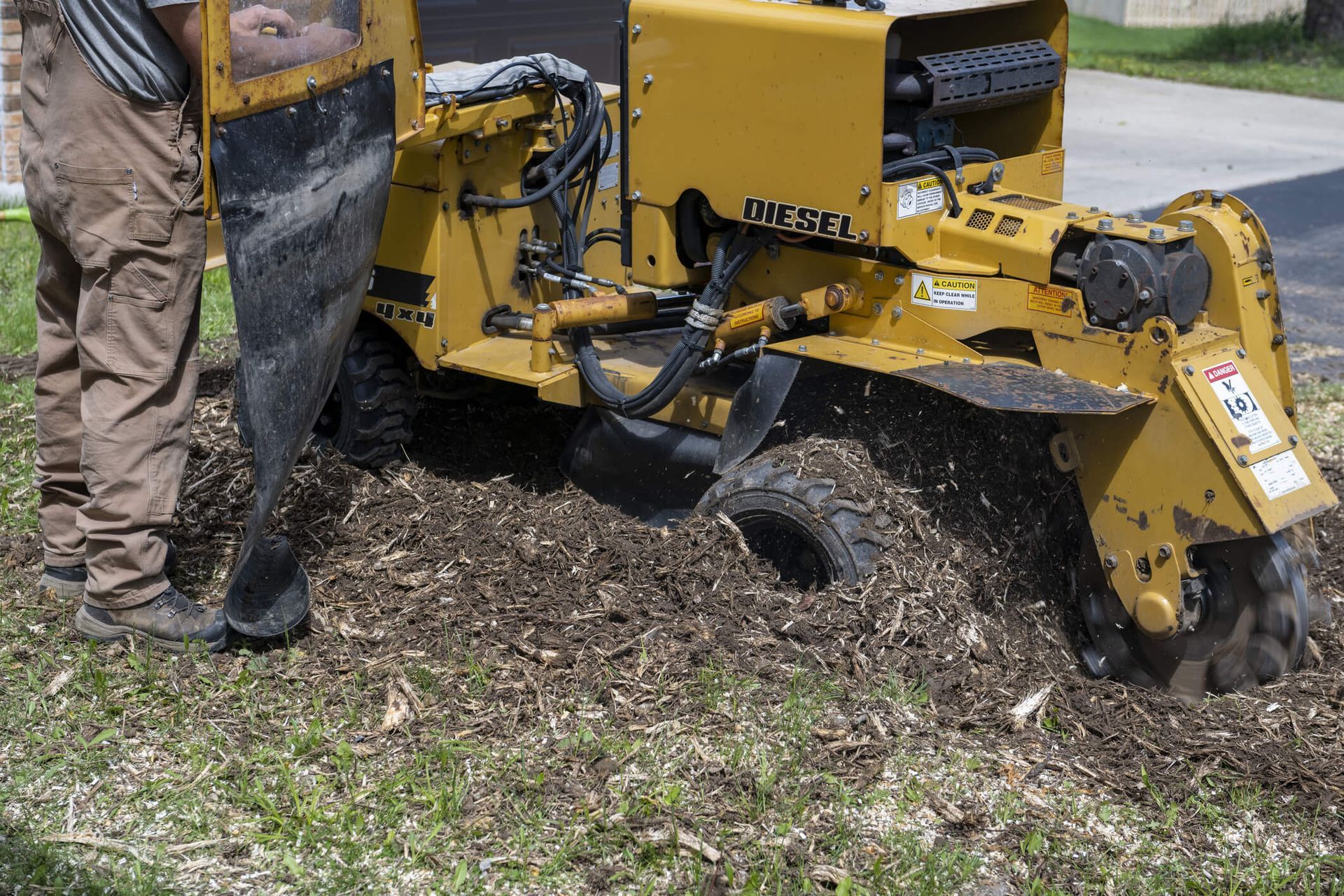
What is Stump Removal?
A more intrusive procedure is tree stump removal, which entails excavating the entire stump and root system. Removing the stump from the ground requires significant equipment and much work. In this case, some homeowners choose this route to eliminate the stump and prevent issues like
sprouts or critters, such as carpenter ants, from taking root. While stump grinding may leave part of the root system behind, stump removal ensures that nothing remains. Although it may cost more money upfront, it can provide a long-term peace of mind and avoid the risk of future problems. SYS Enterprises offers expert tips on navigation through the stump removal process, guiding customers to make the best decision for their property. Whether you choose stump grinding or removal, our team will ensure the best outcome for your yard's health and aesthetics.
Stump Removal Process
Due to the extensive subsurface distribution of tree roots, stump removal frequently necessitates the employment of heavy gear. The best technique to remove a stump is to pull it out of the ground with much power. However, as you might expect, the stump has been replaced by a huge hole. Additionally, large machinery can ruin yards while in use, leaving you a mess.
The optimal uses for stump removal are limited to a few circumstances. For instance, you will likely need stump removal if you remove a lot to build on it. Removal is your best option if you want to plant a new tree exactly where your old one was. However, the best choice for the majority of homeowners is stump grinding.
Advantages of Stump Removal
- Total Elimination: By removing the stump, the whole root system and stump are eliminated, eliminating the possibility of future problems or new growth.
- Get Ready for Fresh Landscaping: The area is clear and prepared for sod, new plantings, or building once the stump and roots are removed.
- Avoids Future Issues: By pulling the roots, you can prevent fungus growth, bug infestations, or damage to underground utilities.
Drawbacks to Stump Removal
- More Expensive: Stump removal is typically more expensive than grinding because it requires digging and frequently uses heavy machinery.
- Time-consuming: The size and depth of the stump might determine how long it takes to remove, often taking a whole day or longer.
- Disrupts Soil: The removal procedure may cause problems with uneven ground or damage to other plants by upsetting the surrounding soil.
What's the Best Choice for Your Yard?
Ultimately, your objectives, financial constraints, and the stump's size will determine whether to grind or remove it.
Select Stump Grinding if:
- You're looking for a quicker and less costly answer.
- The roots being in the ground are not a concern for you.
- There is nothing fresh that you want to plant there.
- The stumps you are working with are tiny to medium.
Select Stump Elimination if:
- For building or new landscaping, you want to clear the area thoroughly.
- Future root-related problems (such as sprouting or pest infestations) must be avoided.
- You have a big, deeply planted stump that could pose issues in the future.
- Comparing Costs of Grinding and Removal
- Cost is one of the most crucial considerations when deciding between stump removal and stump grinding. The size and quantity of stumps, the location, and whether you're using a professional service or doing the work yourself are some variables that can affect the cost. To assist you in making an informed decision, let's examine the price differences between stump removal and grinding.
Costs of Stump Grinding
Generally speaking, stump grinding is less expensive than stump removal. The diameter of the stump and the quantity of stumps that must be ground down are usually used to determine the stump grinding cost.
- Average Cost per Stump: Depending on the size and intricacy of the task, stump grinding typically costs $75 to $500 per stump.
- Cost per Diameter Inch: Many businesses charge between $2 and $5 per inch of the stump's diameter. For instance, grinding a 24-inch stump could range from $48 to $120.
- Savings on Several Stumps: If you have more than one stump to grind, you may be eligible for a reduction, lowering the total cost per stump.
- Additional Fees: If you live far from the service area, transportation may incur additional fees. Stumps in hard-to-reach locations that require more time or specialized equipment may incur additional fees.
Benefits of Grinding Cost
More reasonably priced: Stump grinding is typically the cheapest option for most homeowners.
Fast service: Labor costs are low because the job may typically be finished in a few hours.
Costs of Stump Removal
Since stump removal is a more involved procedure, the cost is typically higher. This technique entails excavating the stump and its root system, which requires extra work and specialized equipment.
- Average Cost per Stump: Depending on the size and depth of the roots, stump removal usually costs between $150 and $1,000 per stump.
- Cost per Inch of Diameter: Like stump grinding, most stump removal businesses charge $3 to $8 per inch of stump diameter, though more significant or profound stumps may cost more.
- Additional Considerations: The placement of the stump (whether it is close to buildings or in a confined area), the state of the soil, and whether the business must deal with massive or firmly entrenched roots all affect how much stump removal will cost.
- Additional Fees: You may be required to pay additional fees for debris removal, backfilling, or yard repair. The overall cost of these services could increase by $50 to $200.
Benefits of Removal Cost
- Complete solution: By removing the stump and its roots, stump removal completely solves the issue and stops further development while being more costly.
- Long-term advantages: Clearing the site of stumps allows you to develop or replant the land.
Cost-Related Factors
- Tree Type and Size: Larger trees or stumps cost more to remove or grind because they take longer. Additionally, certain species might have more extensive or deeper root systems, requiring more work.
- Location of the Stump: Stumps situated on sloped terrain, next to fences or other structures, or in difficult-to-reach places will make the job more difficult and expensive.
- Multiple Stumps: Many businesses provide package discounts or package agreements for bulk services if you need to remove or grind down multiple stumps.
- Accessibility: Because of the additional time and work needed, charges may go up if the stump is in a complex area for large equipment to reach, like next to a fence or in a small yard.
Which Option Offers the Best Value?
Stump Grinding: is ideal if you're looking for a budget-friendly, quick solution. It's beneficial for smaller stumps or when you're planning to wait to replant in the area.
Stump Removal: The higher cost may be justified if you want a clean slate for new landscaping or if the stump's root system is causing potential issues.
Time Considerations for Each Method
Several variables, including the size and position of the stump, the tools utilized, and the task's difficulty, affect how long it takes to grind and remove a stump. By being aware of the time implications for each technique, you can make appropriate plans and select the option that best suits your needs and schedule.
Time for Stump Grinding
Depending on the size and accessibility of the stump, stump grinding is typically the faster of the two choices and can be finished in a few hours.
- Typical Job Duration: Grinding a stump typically takes one to three hours. The size, kind of tree, and location of the stump can all affect this.
- Multiple Stumps: Grinding more than one stump will take longer, but it's still far less time-consuming than removal. For instance, grinding two or three stumps can take three to six hours.
- Small Stumps: Small or shallow stumps (less than 12 inches in diameter) can typically be ground down in less than an hour.
- Big Stumps: Depending on the machine's power and the stump's accessibility, more giant stumps (more than 24 inches in diameter) could take two to three hours to grind.
Factors that Affect Time for Stump Grinding
- Accessibility: If the stump is in a small area or close to obstructions (fences or buildings), the grinder may need to do careful maneuvers, which could take longer.
- Machine Power: Older or less effective equipment may slow the process, but more powerful grinders can quickly finish the task.
Stump Grinding Time Benefits
- Fast completion: Grinding is perfect for people with a tight schedule because it can usually be finished in a few hours.
- Minimal disturbance: You can promptly resume using your space because the procedure is effective and typically doesn't involve significant yard disturbance.
Time for Stump Removal
Stump removal takes longer because it requires excavating the entire stump and root system. Because of the intricacy of the work, stump grinding may take much longer than stump grinding.
- Standard Job Duration: Depending on the size, depth, and placement of each stump, stump removal typically takes 4 to 8 hours.
- Multiple Stumps: Removing several stumps will take longer overall, and the operation can take several days.
- Big Stumps: Removing larger, deeper stumps could take all day (6–8 hours), mainly if the root system is extensive and firmly rooted in the earth.
Factors that Affect Time for Stump Removal
- Stump Size and Depth: Extracting a stump can take longer if it is more extensive and profound.
- Root System: Digging an extensive root system will take longer, mainly if it spreads widely or grows deeply in the ground.
- Access to Equipment: More time may be required to bring in the required equipment or manually remove smaller portions of the stump if it is in an area that is difficult to reach, such as close to fences or confined spaces.
- Post-Removal Tasks: After the stump has been removed, backfilling the hole, leveling the soil, and cleaning up the area may require more time. Depending on the yard's state, this could add one to three more hours.
Benefits of Time for Stump Removal
- Thoroughness: By investing more time, the stump and roots are completely removed, avoiding problems like sprouting or pest infestations in the future.
- Getting Ready for New Landscaping: After removing the stump, the space is free of obstructions and prepared for additional landscaping or planting.
Which Option is Faster?
- Stump Grinding: Stump grinding is the clear winner if you need a quick solution. It can be completed in a few hours and is ideal for homeowners who want to avoid extended disruptions.
- Stump Removal: If you need the area wholly cleared for new landscaping or construction, removal will take longer, but it ensures the stump is eliminated.
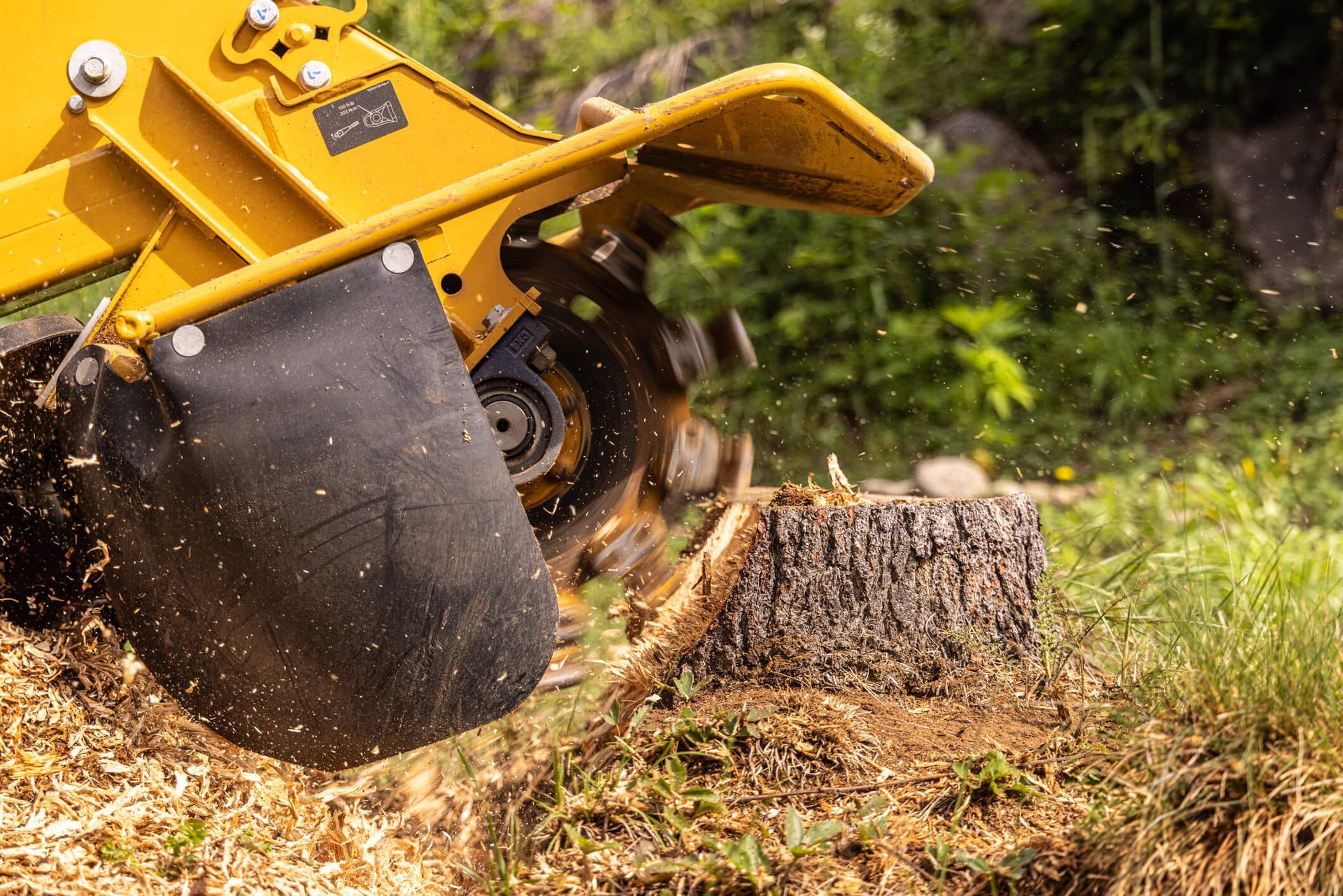
Impact on the Surrounding Landscape
The effect that each technique has on the surrounding landscape is an important consideration when choosing between stump removal and stump grinding. Each procedure has a unique set of benefits and possible disadvantages. Knowing how each technique will impact your yard and upcoming landscaping projects will make the best decision for your home more accessible.
Stump Grinding Effect on the Landscape
Stump grinding is typically less intrusive and less disruptive to your landscape than stump removal. However, it still has some effect on the neighborhood.
Minimal disturbance of the soil
During stump grinding, the stump is ground a few inches below the soil's surface. Although some sawdust and wood chips are produced, the surrounding soil is not significantly disturbed. Because the procedure usually doesn't include heavy machinery or excavation, the surrounding grass, plants, and flower beds are preserved.
Where the stump initially stood, a wood chip-filled depression will remain. Some homeowners turn the wood chips into mulch or compost, but to level the area again, you'll need to fill the hole with dirt or grass seed.
Impact on Neighboring Plants
Usually, stump grinding doesn't damage the surrounding environment. However, if the plants, shrubs, or flowers are too close to the stump, the equipment may sometimes damage them. For instance, the grinding machinery may harm the roots of surrounding plants if the stump is close to a tree's base.
Roots Ignored
One of the main results of stump grinding is that the tree's roots stay in situ. The roots can rot underground while the stump is removed so that they won't obstruct surface-level gardening, but they might eventually pose problems. For instance, if the tree was obstinate or the stump was big, you may notice roots or new shoots breaking the surface.
Considerations for Future Landscape Design
If you intend to replant in the exact location, you must consider the surviving roots. The residual roots may continue to compete with new plants for water and nutrients, even though they often deteriorate with time. To avoid an uneven surface or depressions in your yard, fill the hole by grinding it with soil.
Stump Removal's Effect on the Landscape
Even extensive stump clearance affects the surrounding landscape more. The procedure entails excavating the stump fully, including the roots, which may cause the area to shift significantly.
Severe Soil Unrest
Since the entire root system must be excavated, stump removal is a more intrusive procedure. This frequently entails using large machinery (such as backhoes or excavators), which can seriously disturb the grass and soil nearby.
If not done carefully, the excavation's massive hole in the earth could harm surrounding plants, lawns, and buildings. The hole may be relatively deep and wide, creating a sizable bare area that may take a lot of work to repair, depending on the size of the stump and its root system.
Impact on the Root System
In contrast to stump grinding, which leaves the roots in place, stump removal eradicates the root system. This can cause substantial soil displacement in the surrounding region but removes any possibility of subsequent root growth.
Removing the roots, which may spread beyond the stump, may disturb the surrounding plants and alter the land's structure (e.g., sinkholes or uneven topography).
Restoration Following Removal
After removing the stump, the hole must be filled, leveled, and repaired to blend in with the surrounding landscape. Usually, this entails filling the hole with dirt, reseeding the lawn, or growing fresh grass.
Some dirt may settle over time, and depending on the size of the hole, this restoration process may take some time to appear natural.
Possibility of Long-Term Landscape Initiatives
A solid foundation for the next landscaping will be created by thoroughly clearing the area where the stump was removed. The best option might be to remove the stump and roots if you intend to plant a new tree or do extensive landscaping. For more significant tasks like laying sod, making garden beds, or adding new features, you'll have a more apparent slate to work with.
Conclusion
There are benefits to stump removal and grinding, and the best option for you will depend on your unique requirements. If you need more clarification, speaking with a professional
arborist at SYS Enterprises is always a good idea. They can provide a detailed comparison of the pros and cons of each method, whether you're considering
tree removal,
emergency tree removal,
tree trimming, or pruning. They'll evaluate the situation and recommend the best course of action. Taking care of that tree stump will improve your yard's appearance and help avoid future problems. Whether you grind it down with machines or remove it entirely, addressing the stump will eliminate an eyesore. Left untreated, a tree stump can become a safety hazard or attract pests. The difference in your yard's overall appearance and safety will be evident, so don't hesitate to seek professional
tree services for the best results.
Frequently Asked Questions
Which approach is more effective in stopping new growth?
Since stump removal removes the entire root system, stopping new growth is a more effective way. Over time, new shoots may emerge from the surviving roots, but stump grinding is still proper.
Can I remove or grind a stump by myself?
Both procedures usually require specialized tools. While a rental machine can occasionally be used for stump grinding, professional excavating equipment is typically needed for stump removal. Hiring a professional for both jobs is advised to guarantee efficiency and safety.
What is the depth of stump removal?
When stumps are removed, the entire root system, which may extend several feet deep, is eliminated. Because of this, it's the more comprehensive choice if you wish to clear the area entirely.
What is the depth of stump grinding?
When stump grinding is done, the stump is usually ground 6 to 12 inches below the soil's surface. The root system stays underground, which is typically sufficient to stop regrowth.
If I wish to plant a tree in the exact location, do I need to remove the stump?
Because stump removal removes the entire root system, it can be a preferable choice to plant a new tree or shrub in the exact location of a stump. Roots left over from stump grinding may impede the growth of the new plant.
Is it possible to grind big stumps?
Large stumps can indeed be ground, albeit with more time and work. More giant stumps also require more powerful grinding equipment, which could add time and expense.
After removing a stump, may I plant it again in the exact location?
After the stump is removed, the ground is free of the stump and its roots, making room for new plantings. You can start planting again immediately after backfilling the hole and letting the earth settle.
Can I replant in the same spot after stump removal?
After stump grinding, you can plant again in the exact location, but you'll need to level the ground and fill the hole with soil. Although new plants can still be developed, the leftover roots may eventually present some problems.
After being removed, will the stump grow back?
Stump removal guarantees no regrowth by removing the stump and root system. This approach offers a longer-lasting fix.
After grinding, will the stump grow back?
Since the stump is below the soil's surface, stump grinding does not result in regrowth. However, fresh shoots might emerge from existing roots in the future.
Expert Guidance from Our Tree Care Specialists on Stump Grinding vs. Removal
Do you need help deciding whether to remove or grind your stumps for your yard? Our tree care experts at SYS Enterprises offer knowledgeable guidance to help you choose the best course of action for your particular requirements. Stump grinding is a productive and economical technique that preserves the roots while grinding the stump to below ground level. This is the best choice for homeowners who prefer a speedy fix with little disturbance to the surrounding scenery. However, whether you want to replant in the exact location or need to clear the space totally for new development, stump removal offers a more comprehensive option by completely removing the stump and its roots.
With their knowledge and experience, our trained arborists can assist you in choosing the best approach for your property. Whether you require stump removal for a long-term solution or stump grinding for a quick cure, we guarantee a safe, effective procedure with the least negative effect on your environment. We invite you to contact us for a consultation, during which our staff will assist you in selecting the finest option for the appearance and health of your yard.
